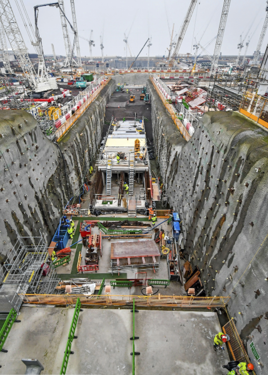Contracts for Difference
Complexity has bedevilled UK efforts to increase power production, which has led to governments across the years flip-flopping over the question of nuclear power. In the mix is not just the complexity and expense of building a power station, but also a question of whether future electricity prices make it worthwhile.
One answer to power generation is ‘Contracts for Difference’ (CfD), as developed by the Department of Business Energy and Industrial Strategy (BEIS). These contracts require companies to bid through auctions to provide low-carbon electricity. From these auctions comes a ‘strike price’, which becomes a fixed and pre-agreed price for that electricity.
Companies receive revenue from selling their electricity. If that price (as calculated as the market reference price) is lower than the strike price, companies receive a top-up to the level of the strike price from the Low Carbon Contracts Company (LCCC), which BEIS owns. This payment comes from a levy on GB electricity suppliers. If the market reference price is higher than the strike price, the companies pay LCCC the difference.
The idea behind CfD is to provide generators with price certainty over the lifetime of their contracts. LCCC notes that as private contracts between it and generators, these deals cannot be unilaterally changed once they are signed.
Their essential ‘pain-gain’ construction is similar to the way train operator franchise contracts once worked. They had ‘cap and collar’ arrangements that typically kicked in after four years.
These arrangements meant that train operators shared with DfT 50% of any fares revenue in excess of 102% of the operator’s original forecast. This shared any gain. To share any pain, DfT would contribute 50% of any revenue shortfall below 98% of original forecasts. DfT’s contribution increased to 80% if the shortfall fell below 96%.
Thus, DfT insulated train operators to some extent from wider economic risks that those operators could not control.
Later deals for commuter operators in southern England used central London employment as the measure of the wider economy. This was shown to be flawed when season ticket sales started falling, even before COVID-19, as more commuters worked from home for a day or two every week. They were still employed in central London, but no longer paying train operators to take them there and back every day.
The lesson from this is that it remains difficult to design risk-sharing mechanisms when they rely on predicting the future.
A second lesson of risk sharing was predicted by the House of Commons Transport Select Committee back in 2006, and demonstrated during the pandemic: “The reason for the lack of risk transfer is primarily because, at the end of the day, no government can afford to let part of the railway system collapse.” In other words, all roads (sorry, rails) lead back to ministers in London, Edinburgh or Cardiff.
Hence the latest round of deals for train operators, through which government takes all the revenue and pays the operator a fee. The wider economic risk lies with government.
This model has worked well for rail concessions. They are subsidised operations, with government or Transport for London buying a level of service from the operator. The model may work less well for traditionally profitable and more commercial operations such as inter-city routes.
CfD has become established in a mature market. Demand for electricity will endure. There’s a distribution network that can take and distribute its product widely across the country. What’s novel is the greener generation that CfD encourages.
Hydrogen is another novel and potentially greener power source. UK government ministers talk about it as a future source of power in homes and as a way of phasing out diesel from transport.
It occurs widely (it’s the ‘hydro’ of hydrocarbons, so exists in the fuels we burn), but doesn’t occur naturally in its pure state. This means it must be extracted from other materials. This can be done by several methods, but both take energy. Steam methane reforming splits it from the gas of the same name, whereas electrolysis splits it from water, leaving oxygen as the waste product.
It might be suitable for a CfD contract if government decides that hydrogen is an energy future. The ‘if’ is important. Were ministers to show the same indecision as has blighted nuclear energy for decades, it’s unlikely that hydrogen will become established.
For rail, the better hydrogen option might be to take a leaf from Aspinall’s book. Establish a self-contained network of trains powered by hydrogen and build a plant to supply the gas. That brings us back to today’s train operating contracts: they deliver to government specification, but don’t have the freedom to invest over the 30-year lifespan of a fleet of hydrogen trains.














